Mass consumption goods. Soviet costume. 1951—1966
Yakov Rumkin, Semion Fridland, Isaak Tunkel, Boris Kuzmin, Alexander Uzlyan, Evgenie Umnov
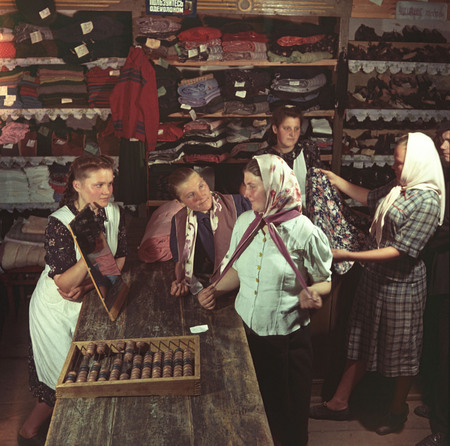
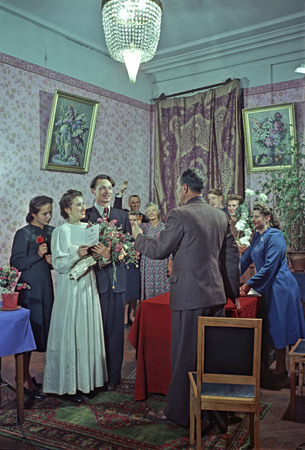
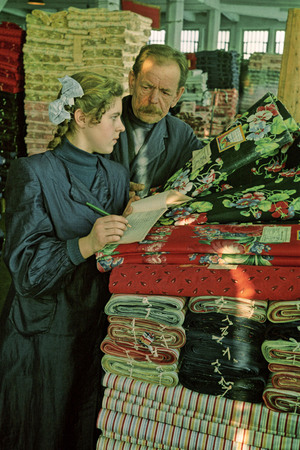
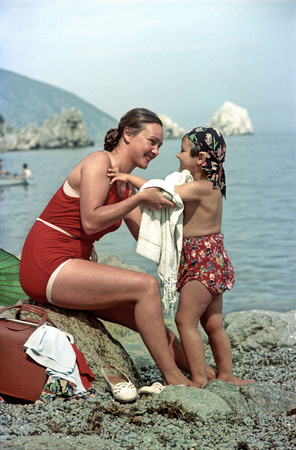
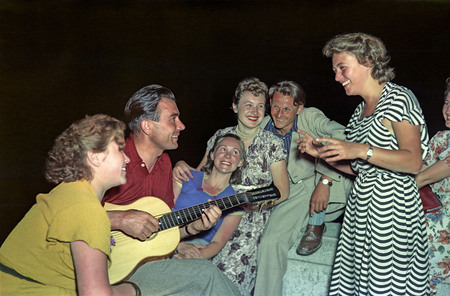

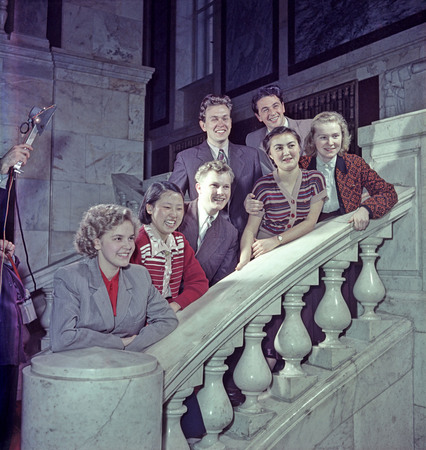
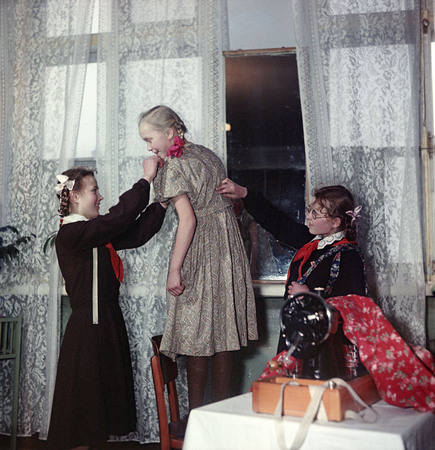
Boris Kuzmin. Assortment of novelties in a country shop of Khizhki village of Kanotliskiy district, Sumskaya region. 1953. “Ogoniok” magazine archive
Isaak Tunkel. Civilian registrar’s office: Vladimir Kisilev, an engineer of State optic factory, and Lyudmila Kisileva, an engineer State machine-building factory. 1952. “Ogoniok” magazine archive
Yakov Rumkin. Vasiliy Grebeshkov, a quality checker of Ivanovo manufactory, transfers experience the young quality checker Ala Novikova. Ivanovo outlet depot. 1953. “Ogoniok” magazine archive
Isaak Tunkel. Valentina Dragunskaya and her daughter Tatiana from Transbaikalia. The Crimea. 1954. “Ogoniok” magazine archive
Isaak Tunkel. Youth at Yalta’s embankment. The Crimea. 1954. “Ogoniok” magazine archive
Semion Fridland, Alexander Uzlyan. In assortment cabinet of Trekhgornaya manufactory concern. Irina Godunova, a young painter, demonstrates the dress made of a new design fabric. Moscow. 1959. “Ogoniok” magazine archive
Evgenie Umnov. MSU students taking part in photo session. Moscow. 1955. “Ogoniok” magazine archive
Semion Fridland. Lyusya Ryakhina made her the first dress. Her friends Sveta Dudinskaya and Nina Smirnova help in final trimming. Vocational school #1. Leningrad. 1958. “Ogoniok” magazine archive
Moscow, 28.03.2009—4.05.2009
exhibition is over
Zourab Tsereteli Gallery of Fine-Arts
19, Prechistenka street (
opening hours: 12:00 - 20:00, Friday 12:00 - 22:00, Sunday 12:00 - 19:00, day off - Monday.
Tel: + 7 (495) 637-25-69
Share with friends
Archive of the “Ogoniok” magazine
Curator: Anna Shpakova
Presented by the Museum “Moscow House of Photography” and the publishing house “Kommersant”
For the press
Ogoniok, 1957, No. 14, p.16
‘Life is better, life is happier!’ This phrase that accompanied Homo Soveticus from 1935 onwards was first uttered by Stalin shortly after the abolition of food rationing, as a symbolic reference to the end of the Holodomor. The slogan acquired sinister overtones when it coincided with the period of mass political repressions that soon followed the temporary victory over hunger.
Life for the Soviet citizen became ‘happier’ yet again in 1948. Not long before the New Year the government annulled wartime rationing of foodstuffs and manufactured goods. In other words, boots and cloth could now be freely purchased in the shops (previously they had been sold in exchange for coupons or on the black market). A comprehensive propaganda campaign backed up this economic development measure. Soviet photographers turned their attention to grocery shelves heaped with goods.
But there was a limit to conditional freedom. On the same day the Council of Ministers introduced ‘norms for the sale of foodstuffs and manufactured goods per customer’ in a bid to curb the enthusiasm of profiteers. These ‘norms’ were not good subject-matter for visual propaganda. Soviet trade was ruled by shortages, with few high-quality goods on sale.
Abolition of rationing for manufactured goods marked the onset of the Soviet consumer society. The first stage in its development lasted just over 10 years, from the end of 1947 to mid-1958. ‘Cotton fabric — 6 m; reels of thread — 1 reel; stockings/socks — 2 pairs; leather, fabric and rubber footwear — 1 pair of each’: in the Fifties every ordinary Soviet woman knew this incantation off by heart. These norms for sales ‘per customer’ continued until 1958. It was the start of a new era.
This exhibition from the archives of Ogoniok reveals for the first time the consumer fever that gripped the Soviet Union in the middle of the last century. Displayed in a form that may already be familiar to readers, as photographs by leading Ogoniok reporters and illustrations in the magazine’s ‘fashion’ supplements. Every step taken by the new consumer culture from cloth manufacturing to the ‘happy life’ of city dwellers was recorded by Ogoniok photographers on assignments issued by the editorial staff. Of course, on the pages of Russia’s leading weekly no trace could be found of consumer fever (queues and even fights for scarce goods: ‘grab it while you can’) or the ‘black market’ (racketeers quickly adapted to the new situation and began dealing in foreign-made goods). This is an official view of events: the brightly-coloured façade of the Soviet consumer machine. A machine that gave rise to a new kind of hunger.
‘Souvenirs will stream from the renowned 1st Moscow Cotton Printing Factory like fruit from a cornucopia. Sixty thousand scarves 50×50 cm with twenty different designs. A hundred thousand children’s kerchiefs in various colours. One million, one hundred thousand smaller souvenir scarves in a hundred different versions. One hundred thousand ‘sets’ in thirty different styles for girls. The ‘set’ comprises a semi-manufactured ensemble that becomes an elegant outfit without any assistance from dressmakers. Eight wedge segments and one triangle are printed on a length of calico. The wedges are sewn together like ‘sunbeams’ and the skirt is ready. Tie the triangle round your head and it becomes a kerchief to match the skirt.
About ten Moscow garment factories have begun sewing 86 models by designers from the All-Union House of Fashion. Dresses that ‘show off the silhouette’, in the language of fashion stylists, combining ‘decorative effect’ and ‘joie de vivre’, all at an affordable price.’
V. Polynin. K festivalyu!


